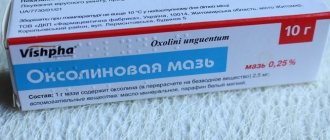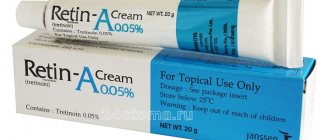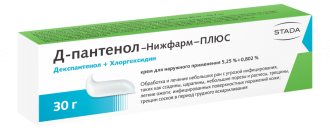A topical medicine based on natural ingredients helps to get rid of the unpleasant consequences of bruises, sprains, hypothermia, seasonal exacerbations of joint inflammation, and symptoms of myositis. It is recommended to buy the drug and always have it in your home medicine cabinet, since the need for it may arise suddenly.
Indications for use Viprosal B
What is the ointment used for?
The drug is used in the presence of pain in patients with arthritis of various etiologies. Also used for rheumatic pain, to treat neuralgia , myalgia , sciatica and sciatica (lumbosacral sciatica).
The use of the ointment is justified for patients with lumbago , that is, attacks of fairly intense pain in the lumbar region.
How does Viprosal work?
Therapeutic ointment has the properties of expanding the network of capillary vessels, irritating local receptors, improving tissue trophism and reducing pain. The product is applied to the skin in the area where muscles or joints are affected. The poison and other components have a distracting effect, affect nerve endings, promote the outflow of inflammatory products, prevent stagnation, eliminate the feeling of pain, aching, help relieve stiffness and restore normal mobility of the diseased part of the body.
The effect of application develops within 15–30 minutes and lasts up to 6–8 hours. When used correctly, the components of the drug are absorbed into the bloodstream in small quantities. They have virtually no systemic effect on the body.
Contraindications
The ointment is not prescribed to patients who have skin diseases, including purulent and allergic diseases.
Also contraindications to the use of viprosal are a feverish state, an active form of pulmonary tuberculosis , severe disturbances in the functioning of the liver, severe disturbances in the functioning of the kidneys, cachexia (the highest degree of exhaustion of the body).
The ointment should not be used if the patient has severe insufficiency of cerebral and coronary circulation, as well as a tendency to vasospasms.
Viprosal is not prescribed to pregnant women or breastfeeding mothers.
The drug should not be used by patients who are highly sensitive to the components of the drug.
When is Viprosal indicated?
It is recommended to use medicinal ointment for patients over 12 years of age:
- with myositis: inflammation of muscle tissue, accompanied by pain and stiffness;
- for neuralgia: reactions of inflamed or compressed nerve endings, expressed in acute shooting pain attacks;
- for arthralgia: pain in the joints of the extremities: due to inflammatory processes of soft tissues, degeneration of cartilage or bone structures;
- for lumbodynia: back pain caused by physical overload, osteochondrosis.
According to reviews, Viprosal helps relieve pain of mild to moderate intensity and can be used independently for myositis. In cases of severe back pain and radicular syndrome, it is often necessary to supplement the effect of the drug with systemic NSAIDs in the form of injections and tablets.
Viprosal B ointment, instructions for use (Method and dosage)
According to the instructions for use, Viprosal B is used externally, applied to painful areas of the skin.
Before rubbing the drug in, rinse the areas of skin to which it will be applied with warm water. The ointment should be applied once a day. In this case, the dose of the drug should be 5-10 g, which is equal to 1-2 teaspoons.
Viprosal is gradually rubbed into the skin. If the pain is severe enough, then you should use this drug twice a day until the pain stops.
As a rule, the general course of treatment lasts ten days. It is very important to wash your hands thoroughly after rubbing the drug in so that the ointment does not get into the eyes and mucous membranes.
The product is not produced in tablets.
Composition and dosage form
Everyone knows what a strong therapeutic effect snake venom has. By irritating the skin, it penetrates the capillaries, stimulates circulation and reduces severe pain. Lotions based on it have always been used for radiculitis and other pathologies of the musculoskeletal system. Viprosal also contains snake venom - a dried extract of viper glands. This substance ensures activation of metabolic processes and increases blood flow to the affected area. Other active ingredients of the drug:
- camphor - has a cooling, analgesic and moderate anti-inflammatory effect;
- pine resin turpentine: helps eliminate swelling;
- salicylic acid: disinfects, relieves inflammation, relieves painful symptoms.
Viprosal is available in the form of an ointment for external use: a homogeneous viscous mass, slightly oily, white or slightly yellowish in color. Auxiliary components of the medicine: petroleum jelly, soft paraffin, glycerin, sodium chloride and water. The drug is packaged in metal tubes of 30, 50 and 75 ml.
Analogs
Level 4 ATC code matches: Dolobene
Nayatoks
Finalgon
Apizartron
Bee venom
Gavkamen
Dimexide
Menthol oil
Gum turpentine
Capsicam
Tizol
Camphor alcohol
Turpentine ointment
Formic alcohol
Mataren Plus
Dimethyl sulfoxide
Fast Relief
It has no structural analogues.
Viprosal B price, where to buy
The cost of a 30 g tube is approximately 240 rubles.
The price of Viprosal B ointment 50 g is 310 rubles.
- Online pharmacies in RussiaRussia
- Online pharmacies in UkraineUkraine
- Online pharmacies in KazakhstanKazakhstan
ZdravCity
- Viprosal in ointment d/nar.
approx. tube 30g JSC Tallinn Pharmaceutical Plant RUB 329 order - Viprosal B ointment for external use. approx. tube 50 g JSC Tallinn Pharmaceutical Plant
RUB 463 order
- Viprosal in ointment for external use. approx. tube 75 JSC Grindeks/JSC Tallinn Pharmaceutical Plant
RUR 519 order
Pharmacy Dialogue
- Viprosal “B” ointment 30g Tallinn HFZ
RUB 263 order
- Viprosal “B” ointment 75g Tallinn HFZ
470 rub. order
- Viprosal “B” ointment (tube 30g) Tallinn HFZ
RUB 297 order
- Viprosal “B” ointment 50g Tallinn HFZ
RUB 373 order
show more
Pharmacy24
- Viprosal 30 g ointment Tallinn FZ, Estonia
85 UAH. order - Viprosal B 50 g ointment Tallinn Federal Plant, Estonia
111 UAH order
PaniPharmacy
- Viprosal B ointment Viprosal B ointment 50g Estonia, Tallinn Federal Law
132 UAH order
- Viprosal B ointment Viprosal B ointment 30g Estonia, Tallinn Federal Law
94 UAH order
show more
Viprosal B in the treatment of rheumatic diseases
In the diagnosis of many rheumatic diseases, it is important to determine not only the location and intensity of pain, but also the differentiation of its nature into inflammatory and mechanical. Inflammatory pain is most pronounced in the early morning hours, is accompanied by severe and prolonged morning stiffness and is significantly relieved by physical activity. In turn, pain of the mechanical type usually occurs during exertion, at the end of the working day, or when the patient is in a standing position for a long time. Moreover, this type of pain is not accompanied by rigidity or is mild and lasts no more than 30 minutes. If pain of the inflammatory type is characteristic of inflammatory diseases of the joints and spine, then of the mechanical type is characteristic of osteoarthritis and intervertebral osteochondrosis. Inflammatory pain is included in the diagnostic criteria for ankylosing spondylitis. The dynamics of pain intensity is one of the indicators of response to therapy and a criterion for remission in this disease (ASAS response criteria and ASAS remission criteria) [1]. The intensity of pain, along with morning stiffness, adequately reflects the activity of the inflammatory process in rheumatoid arthritis, ankylosing spondylitis and other pathological processes, and to a greater extent than laboratory tests such as ESR and C-reactive protein levels. The dynamics of pain severity in many diseases allows us to judge the effectiveness of the therapy. Although OA is considered a major degenerative joint disease, there is now compelling evidence suggesting an important, and perhaps critical, role for inflammation in the development of this disease and its progression. The inflammatory process in OA is localized not only in the synovium, but also in hyaline cartilage, bone and periarticular soft tissues. A large cascade of pro-inflammatory mediators takes part in its implementation [2]. Of key importance is interleukin-1β (IL-1β), which is expressed in osteoarthritis cartilage and stimulates the production of metalloproteinases. This cytokine also inhibits the expression of collagen and proteoglycans, promotes the synthesis of plasminogen activator, and stimulates the synthesis and release of certain eicosanoids - prostaglandins and leukotrienes. It determines the level of the catabolic process in OA. Along with IL-1β, other pro-inflammatory cytokines (TNF-α, IL-6, IL-8, IL-17, oncostatin-M, leukemia inhibitory factor) are also involved in the pathogenesis of this disease. The presented data indicate that a wide range of mediators are involved in OA, aimed at inducing the inflammatory process in joint tissues, and emphasize the advisability of using drugs with anti-inflammatory activity in the treatment of this disease. The most significant clinical manifestations of OA are joint pain and limitation of active and passive movements. This disease is characterized by a gradual onset, increased pain in the joints during exercise, deformation of the joints due to slight effusion or thickening of the synovial membrane, short-term morning stiffness, which usually does not exceed 30 minutes, crepitus or periarticular crunching during movements in the affected joints, instability of the articular surfaces with the formation of subluxations. A characteristic feature is bone growths in the area of the distal and proximal interphalangeal joints of the hands (Heberden's and Bouchard's nodes). Therapy for OA involves eliminating external factors that contribute to its development, reducing or completely relieving pain in the joints and restoring their function, influencing the manifestations of reactive arthritis, and preventing its further progression. Drug therapy includes two main classes of drugs: 1) immediate-acting symptomatic drugs; 2) drugs that structurally modify cartilage. If the first group is aimed at suppressing the subjective manifestations of the disease, then the second group is aimed at slowing the rate of progression of osteoarthritis. Symptom-modifying drugs include primarily non-steroidal anti-inflammatory drugs (NSAIDs), without which complex therapy for OA is unthinkable. Their prescription is justified by the presence of an inflammatory process in the joint tissues in this disease. The positive effect of NSAIDs in OA is determined not only by their anti-inflammatory effect, but also by a clear analgesic effect. According to the recommendations of the European League Against Rheumatism (2003, 2004), NSAIDs for this disease should be used both locally and systemically. It should be borne in mind that almost all patients with OA are elderly and they experience an increase in the frequency and severity of side effects of NSAIDs when used systemically. From this perspective, local therapy with NSAIDs seems relevant, as it allows one to avoid numerous adverse events from their use. The wide range of adverse effects of NSAIDs has led to the search for other effective methods of treating diseases of the musculoskeletal system, which include local therapy. This therapy involves the local use of NSAIDs, capsaicin, dimexide, and drugs containing natural poisons. This also includes local injection (intra-articular and periarticular) therapy with prolonged glucocorticoids, hyaluronic acid preparations, alflutop or adgelon. A positive aspect of local therapy is the targeted delivery of a drug that acts directly on the painful area without affecting other tissues. At the same time, as a rule, there is a high safety of drugs, since their concentration in plasma remains small and is several times higher in joint tissues. Local therapy includes Viprosal B ointment. Viprosal B ointment is a mixture of several known irritants: salicylic acid 1%, camphor 3% and turpentine 3%. These locally acting drugs have been used successfully for several decades. Camphor acts as a local irritant and as a mild analgesic. It is used in various ointments and gels. At a concentration of 1–3% it affects skin receptors and is used as a local analgesic and antipruritic, and at a concentration of more than 3% it stimulates the nerve endings of the skin and causes a decrease in the intensity of pain and discomfort [3,4]. Turpentine is a primary irritant and sensitizer. It is included as a component in irritating drugs and has proven itself to be an effective and safe agent [3]. The main component of Viprosal B is viper venom: it is a complex mixture of proteins, many of which have an enzymatic effect. The poison contains proteolytic enzymes like thrombin, phosphatase, phosphodiesterase, L-amino acid oxidase, and others. Small concentrations of the venom applied to intact skin have no systemic effects because its proteins do not penetrate the skin. It is assumed that when applied topically, the poison acts as an irritant. Although Viprosal B ointment is a mixture of counter-irritating components, they are contained in small concentrations and therefore do not lead to excessive skin irritation. On the other hand, the pharmacological activity of individual components is achieved through various mechanisms, which determines the clinical effectiveness. Counterirritation is a paradoxical effect that leads to pain reduction. When applied to the skin, counterirritants stimulate a local inflammatory response. The goal is to provide pain relief in another area, usually adjacent to or below the surface of the skin [5,6]. In addition to Viperae berus snake venom, camphor, turpentine and salicylic acid, the ointment includes paraffin, petrolatum, glycerol, emulsifier, isotonic saline solution and purified water. This base of Viprosal B ointment ensures the gradual release of active components and their long-term action directly in the pathological focus. The biological effects of Viprosal B are manifested in analgesic and anti-inflammatory activity, as well as the ability to restore the functions of damaged tissues. The drug is quickly absorbed from the surface of the skin, penetrates deeply into the affected tissue, forms a concentration gradient between the skin and the synovium of the joint, quickly begins to act, and does not leave greasy stains on clothing. Viprosal B is produced by Tallinn Pharmaceutical) in aluminum tubes of 30 and 50 g. The preparation and packaging of the drug is carried out according to GMP standards. In a clinical trial, conducted with the sponsorship of the Tallinn Pharmaceutical Plant, the effectiveness and tolerability of Viprosal B was studied. The comparison drug was a placebo ointment, the composition of the base is identical to Viprosal B, but does not contain 4 active components - Viperae berus venom, salicylic acid, camphor, gum turpentine. The test drug is applied in a thin layer to the skin of the painful area 2 times a day. - in the morning and in the evening. The design of this was a randomized, placebo-controlled, parallel group, double-blind study. The objects of the study were patients with pain caused by joint diseases and other musculoskeletal pathologies. The purpose of this study: to evaluate the clinical effectiveness and safety of Viprosal B ointment in the treatment of mild to moderate pain in patients with low back pain, neuralgia, OA and soft tissue diseases - tendonitis, myositis and bursitis. The main purpose of the study was a comparative evaluation of Viprosal B ointment compared with placebo in terms of its effect on pain intensity. No other medications (ointments, lotions, emulsions, etc., including cosmetics) were used in the same area or area adjacent to the area of skin to which the study drug was applied. Systematic use of antirheumatic, anti-inflammatory or analgesic drugs other than paracetamol was also not permitted. The criteria for the effectiveness of the therapy were the following indicators: pain assessment according to VAS ranging from 0 (no pain) to 100 mm (unbearable pain). Spontaneous pain was scored as follows: 0—no pain, 1—slight pain, 2—moderate, 3—severe, and 4—very severe. Pain during movement and palpation was assessed on the same scale as spontaneous pain, and joint swelling was assessed on a scale from 0 to 3 points, where 0 is no swelling and 3 is severe swelling. In addition, the number of paracetamol tablets used was recorded. The study included 92 male and female outpatients aged 18 to 70 years who were not taking any systemic or local analgesics. Inclusion criteria were: OA of the knee or hip joint, or polyosteoarthrosis, pain in the spine without significant radiological changes, sciatica, cervicalgia, lumbago, soft tissue bruises. The duration of treatment was 7 days. 88 patients completed the study - 44 patients each in the control and experimental groups. This study included three follow-up visits with patients: before the start of the study, an intermediate visit during the study, and a final visit after completion of the randomized clinical trial. The corresponding treatment parameters with Viprosal B ointment and placebo ointment were subjected to statistical processing. All data on the effectiveness and safety of this study were processed by descriptive statistics, determining the arithmetic mean, standard deviation and standard error, lower and upper 95% confidence intervals and coefficient of variation. Statistical analysis of effectiveness was performed based on the results of analyzes of patients who completed the 7-day course of treatment. The study groups were identical in terms of the main parameters of the pathological process studied in this work. The average values of spontaneous pain before treatment in the placebo group were 2.07 ± 0.11 and in the Viprosal B group 1.84 ± 0.13, and the average values of pain during movement were 2.57 ± 0.12 and 2.57 ± 0. 09 respectively. The average pain value according to VAS was 51.66±2.59 for placebo and 50.61±2.41 in the Viprosal B group. Statistical comparison of baseline features showed no significant difference at the 5% level with respect to any parameter studied. As follows from Table 1, after treatment, the average VAS value for placebo was 32.1 with a 95% confidence interval (25.4; 38.7), and the average value for Viprosal B ointment was 22.7 with 95% significant confidence interval (17.9; 27.7), at p=0.025. Although the histograms of the obtained data support the assumption of a Gaussian distribution, the Wilcoxon test corresponded to p = 0.055. The mean change in VAS score for placebo was 19.6 with a 95% confidence interval: (–25.4, –13.7), and for Viprosal B ointment – 27.9 with a 95% confidence interval. The statistical analysis performed showed that the difference is significant at the 5% level. Spontaneous pain score After treatment, the mean value for placebo was 1.23 with a 95% confidence interval (0.94, 1.51), while for Viprosal B the mean value was 0.75 with a 95% confidence interval interval (0.57; 0.92). The mean change for placebo was (–0.84) with a 95% confidence interval (–1.10, –0.58). Viprosal B ointment was characterized by a more pronounced reduction in spontaneous pain (–1.09) with a 95% confidence interval (–1.36; –0.82). Movement pain score After treatment, the mean value for placebo was 1.57 with a 95% confidence interval (1.31, 1.83), while for Viprosal B the mean value was 0.95 with a 95% confidence interval interval (0.74; 1.17). The mean change for placebo was (–1.0) with a 95% confidence interval (–1.26, 0.73). Viprosal B ointment was characterized by a significantly more pronounced reduction in spontaneous pain (–1.61) with a 95% confidence interval (–1.89; –1.34). Result by Wilcoxon test p=0.0027. Changes in the average values when using placebo and Viprosal B ointments before and after treatment are presented in Figures 1, 2 and 3. As for the severity of swelling, the small number of patients with exudative phenomena in the joints and the short duration of therapy did not lead to significant differences as between groups of patients, as well as the dynamics of this indicator in each individual group. There were no significant differences in the average number of paracetamol tablets taken, although slightly fewer tablets were taken by patients in the Viprosal B group. Viprosal B showed good tolerability. No adverse events were recorded while taking it. In one case, urticaria was observed several days after starting to apply a placebo ointment that did not contain snake venom. Some patients did not like the smell of the ointment. However, this subjective opinion was not recorded as an adverse event. To summarize the study, it should be noted that it convincingly demonstrated the effectiveness of Viprosal B. A significant difference between the test drug placebo was identified in such indicators as a decrease in pain during movement and palpation (p <0.01). The difference in the dynamics of VAS results was also significant between the main and control groups (p <0.05). Fewer painkiller tablets were consumed in the Viprosal B group: 3.95 tablets compared to 6.11 tablets in the placebo group, although this difference was not statistically significant due to the large standard deviation in this parameter. This study demonstrated the safety of Viprosal B ointment and no adverse events were identified during a one-week course of treatment with this drug. The use of the drug Viprosal B contributed to a rapid and significant reduction in pain intensity without any increase in the risk of its negative effects. The average consumption of Viprosal B ointment per patient for a 7-day course of treatment averaged 17.5 g, or 1.25 g per 1 dose, which indicates favorable pharmacoeconomic parameters for the use of this drug. Thus, Viprosal B ointment has high anti-inflammatory and analgesic activity and demonstrated significant positive dynamics of disease activity in patients with OA and soft tissue diseases. The drug was well tolerated, no skin irritation was detected, and in no case were gastrointestinal complications recorded or hepato-, cardio-, or neurotoxicity encountered. Good tolerability and high safety allow us to recommend this ointment for external use. Viprosal B can be used both in monotherapy and in combination therapy for diseases accompanied by moderate pain - joint, muscle and neurological.
References 1. Dougados M., Dijrmans B., Khan M. et al. Conventional treatments for ankylosing spondylitis. Ann Rheum Dis 2002; 61(Suppl. III): 40–50. 2. Badokin V.V. The feasibility of using non-steroidal anti-inflammatory drugs in the treatment of osteoarthritis. Difficult Patient 2010; 11 (8): 26–30. 3. Jacknowitz AI. External analgesic products. In: Handbook of nonprescription drugs, Id» ed. American Pharmaceutical Association, Washington, 1993: 551–562. 4. Reynolds, J. E. F., ed. Martindale, the Extra Pharmacopoeia, 31st ed. Pharmaceutical Press, London, 1996: 1684. 5. Green BG (1991) Interactions between chemical and then nal cutaneous stimuli: inhibition (counterirritation) and integration. Somatosens Mot Res 8:301–312. 6. Wilier JC, Roby A, Le Bars D (1984) Psychophysical and electrophysiological approaches to the pain–relieving effects of heterotopic nociceptive stimuli. Brain 107:1095–1112. 7. Russell FE. Toxic effects of animal toxins. In: Casarett and Douff's Toxicology: The Basic Science of Poisons. McGraw-Hill, New York, 1996:. 801–809.




